In this article, we will be discussing what houseplants can be grown in the home to give welcome scent. Often when we want to give scent to our homes, we use artificial means of air fresheners, potpourri, or air purifiers, but there are houseplants that can fulfil the air with such pleasant odours that you wonder what you did before you bought one.
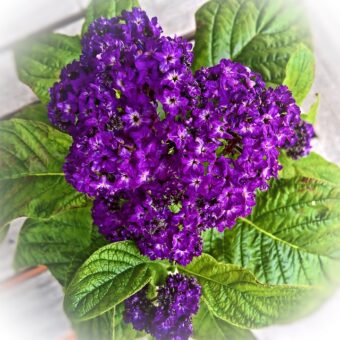
Houseplants, unlike the other means, introduce natural ways of introducing smell to the home and they often look beautiful as well. You are not only adding scent to the home but you are also adding something that will beautify it as well.
Many houseplants can be used to meet this brief, all having a distinct smell, be it a subtle smell or a more powerful scent that will lighten any mood. These are some special plants that look good and smell divine in anybody’s home.
The following plants are recommended for their scent and their beauty:
BRUNFELSIA PAUCIFLORA(Yesterday, Today, Tomorrow Plant)
Such a strange name for a houseplant, where its common name alludes to the changing colours of the flowers from purple to white as they age. Not only this but the flowers are fragrant all year round and it has graceful, glossy, green leaves. It is quite a tall houseplant growing up to 60cm in height.

Grow it in a cool, but not chilly or draughty place. It prefers to be grown in slight shade in summer, where a 13cm diameter pot should be sufficient to meet its growing requirements. Temperature is important, avoid both chill and excessive warmth and any sudden change in the temperature.
A plant that hates roots disturbance so avoids potting on as much as possible. The compost must be moist all year round, where in summer it must be misted. Only feed during the active growing season. Varieties with smaller flowers tend to be easier to grow and look after than the large flower varieties.
CATTLEYA
These are good plants for orchid novices to try. They are easy to grow and more importantly easy to bring into flower. The blooms are beautiful to look at and are sought by orchid growers.
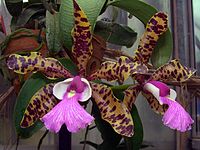
More than this the flowers are often scented. The flower consists of five large petals that are pulled back from a central tube that is often frilled or ruched at the end. The stems often appear above green leaves and structures known as pseudobulbs, where each stem usually holds 5 to 6 flowers.
They often make great hanging basket specimens, where it can grow up to 45cm in height.
Grow them in a sunny windowsill in average temperature but higher temperatures in autumn. You need to water moderately in summer and sparingly in winter. The plant requires high humidity and therefore misting it regularly will be beneficial and where in summer an occasional feed with a houseplant liquid fertilizer will not go amiss.
CONVALLARIA (Lily of the Valley)
This favourite outdoor plant can be often grown indoors because of its beautiful, dainty flower and the scent it brings to the home in the depths of winter. They are not a plant and forget houseplant, as the delicate hanging bell flowers appear on slender stalks that take your back to spring woods, will soon fade.

Once the flowers have faded they need to be planted back outside in a container or the garden. Saying that it does bring welcome colour and scent in the bleak mid-winter months, where they make a great centrepiece. The leaves are not worth writing home about.
This plant likes to be grown in direct sunlight in a cool room. The compost should be moist at all times but it does not have to be misted at all. Do not feed at all, as after it has finished flowering it need to be planted outside.
CYCLAMEN
These are bold specimen plants that add colour in autumn and winter. This is why these plants are adored by thousands. Normally cultivars of cyclamen appear in autumn where they can remain in bloom until late winter.
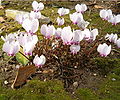
This is why they make ideal houseplants to brighten up any home. The flowers come in shades of white, pink and purple, whilst some are often sweetly scented. The leaves themselves are attractive, often dark green with silver variegation.
Grow them in good, bright light in average temperature; cool whilst it is flowering. You will need to water normally and mist occasionally whilst the plant is not in bloom. Once it is flowering, you need to reduce the watering rate to prevent root rot. The compost needs to be moist at all times and during the growing season feed with a half-strength liquid houseplant fertilizer, where it can grow up to 22cm on height.
EPIPHYLLUM
This is a large succulent that has large, beautiful flowers that are often scented. Some species have flowers that only open at night, whilst other only during the day. Epiphyllum crenatum is a large succulent growing up to 3m in height, where creamy-white flower encased in pink out petals appear. The green leaves are quite dramatic and look like an upright fern.

E. anguliger is much more compact, only reaching 1 m in height and has yellow flowers. It does not mind growing in standard houseplant compost, as it does not need a specialized growing media.
Grow it in light shade in warm conditions. Water well while the plant is in flowers then you need to move it to a cooler site and start reducing the watering rate. After a few weeks rest, restart normal watering. In winter, water sparingly and feed occasionally during the growing season.
EXACUM AFFINE (Arabian Violet)
This is a compact plant that has a profusion of small, mauve flowers with yellow centres that are often fragrant. The leaves may not be spectacular but the flowers are, where it can reach a height of 22.5cm. This is not one for a long keeper, as it should be discarded after flowering. If it is still growing, you should not pot it on to a larger pot than 13cm in diameter.

The biggest problem is that plants you buy from shops are not always scented in its quest to produce flowers. This plant does not need to be fed at all, so is well worth looking out for.
Grow it in a moderately warm room in light shade, where it should stay in flower for several weeks, as long as you keep it out of draughts. Keep moist at all times especially so in rooms that are centrally heated. You can grow them easily from seed sown on a window sill in April. ‘Starlight Fragrant’ has a powerful scent, so is the variety to grow.
GARDENIA
If you are looking for a graceful, old-fashioned houseplant, which looks good and the flowers have such a delicious scent then this is the plant for you. This makes it a firm favourite for growing indoor, although in milder area of the UK it is at home outdoors.

Gardenias have everything that you look for in a houseplant. The flowers have shades of creamy-yellow and whites and are often double in nature. It has a scent that is difficult to erase from the memory, as it is so intoxicating. The leaves are dark green and extremely glossy and look attractive even if it is not in flower.
This is not a leave alone plant, as if the conditions are not right the flowering buds have a tendency to fall off. It needs a site in good, bright light in average temperature but not below 16 degree Celsius, where it can grow up to 2m in height. Make sure the compost does not dry out at all times.
HELIOTROPIUM (Heliotrope)
If you are looking for the best scent of all houseplants, then heliotrope is for you. The flowers of violet and purple are formed in mounds and look stunning in their own right and are produced of elegant, large leaves. A smell that is never to be forgotten.

It is a small plant, only growing to 45cm in height and they are extremely easy to look after. Heliotropes are often seen as bedding plants outdoor in summer and therefore can take draughts and changes in temperatures with little fuss.
Grow them in bright, indirect scent in cool to average temperature. Water moderately in summer, more sparingly in winter. It will need a liquid fertilizer to be used once a month during the growing season, where the plant will need to be pruned regularly. It is easy to grow from seeds planted in March-April.
HYACINTHUS (Hyacinth)
This familiar bulbs need no introduction and are one of the best bulbs for forcing. It comes in a full range of colours from orange, pink, red, yellow, white to shades of blue and deep purple. The colours are outstanding but the scent is something to remember where it can be adored throughout the home.

Hyacinths are usually bought as bulbs in autumn and they are either planted in a group in bowls or pots or they can be grown in special glass vases.
They prefer to be grown in bright filtered lights in a cool to average temperatures where it can reach a height of 25cm. It is advised to keep the plant in a cool and dull location before it flowers. Once it starts to flower move it to bright, filtered light. You need to water carefully as bulb establishes to avoid the bulb from rotting. Increase the watering rate once the bulbs start to flower.
HYMENOCALLIS (ISMENE) (Peruvian Daffodil)
This is a large bulb that has highly scented daffodil –like flowers that appear from March to April. They are normally grown as you would an amaryllis, where you have to keep the bulb dry over winter to prevent it from rotting.
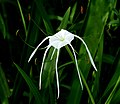
If you are buying bulbs make sure that you buy large bulbs, as small bulbs may not have reached a mature size and will not flower. Varieties to look for is ‘Zwanenberg’ that can be grown outdoors in mild areas, ‘Advance’ that have very large flowers and ‘Sulphur Queen’ which is pale yellow.
Grow them in a cool but not cold, moderately humid location in slight shade, where the scent can be engaged. As the bulb grows, you will need to keep it moist throughout the growing season, whilst keeping almost dry in winter.
JASMINUM (Jasmine)
This is a delicate, twining climber that produces masses of tiny, white, star-shaped flowers throughout winter and spring. The flowers are beautiful but the scent is well worth the effort.

It is best to train this climber over wires or frames, but it is a vigorous plant and will take over any room you want to train it into. Grow it in bright, indirect light in average temperature but no lower than 13 degree Celsius, wherein can grow up to 3m in height,
You need to water normally during summer, sparingly in winter. During the growing season, you will need to feed with a balanced, high potash houseplant fertilizer.
LILIUM (Lily)
You can grow these scaly bulbs indoors, where often colourful trumpet-shaped flowers are produced that are often scented. You will need to plant them in autumn to early spring, just leaving the tip protruding from the top of the compost. No matter what growing media you use, you have to make sure it is free draining, It is best to start the plant outdoors and then when growth is observed you can bring it indoors.

You need to gradually introduce the bulb too bright lights, as it can suffer in bright if suddenly introduced to bright lights. Lilies prefer to be grown in a cool, airy location, avoiding high temperature at all costs
Many varieties can be grown but Lilium umbellatum is the preferred variety. You will need to feed whilst the lily is in flowers. Once it has finished flowering you cannot get them to flower indoors again and so you will need to plant them outside.
LYCASTE AROMATICA
This is an orchid with green, deciduous leaves and on top of these, short stems of fragrant red-tipped, golden yellow flowers are produced in early spring.
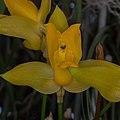
It is best grown in a 13cm diameter pot full of suitable orchid compost. Alternatively, it can be grown in moss situated in an orchid basket or wired into pieces of mossy tree branches.
It prefers to be grown in moderate warmth and humidity in the shade, where a temperature above 10 degree Celsius needs to be maintained.
When the leaves are growing, you need to water freely but very little is required when they have faded and the plant has stopped growing. Saying that you still need to water to prevent the pseudobulb from shrivelling up.
NARCISSUS (Daffodil)
Flowering daffodils are wonderful plants to have both indoors and outdoors and the beauty is most homegrown daffodils are scented. They bring a fresh feel to any room they are grown in and once spring has arrived the show begins.
Narcissus are usually bought as bulbs in autumn, where they can be potted up in groups in containers, You can but specially prepared bulbs and these will flower much earlier than those grown outdoors. The best varieties to grow indoors are ‘Paper White’, where flower stems have a cluster of white scented flower and ‘Tete a tete’, the firm outdoor favourite.
If you are buying bulbs you need to make sure that they are healthy looking and firm. Best planted close together in a shallow tray and cover with compost so that the growing tips of the bulb are just below the compost surface.

You will then need to water throughout. Once the plant has been planted, they need to be kept in a cool, dark area for around 6 weeks. To get the best out of daffodils indoors, it is advised to start the bulbs outdoor in a good spot such as inside a shed, making sure the compost never dries out. Once shoot start to appear you can bring the bulb into a lighter spot.
After 3 weeks flower buds should start to form and at this stage, they can be brought indoors to a bright but cool windowsill, where the flower can be enjoyed.
Grew them in the home in bright, indirect light and you have to water carefully. Once the bulb starts to grow, you will need to increase the watering rate and once it starts to flower you need to feed once a week until the flower fades and dies.
PELARGONIUM (Scented Leaved Geraniums)
This is a bushy, shrubby plant that has strongly fragrant leaves, especially if they are crushed. The plants come in many varieties that often have pretty names, which are often descriptive of the scent they produce: rose, nutmeg, lemon, orange, pine, eucalyptus, apple, and many more.

Old plants can become very scraggily and woody and it may need drastic cutting back unless you prefer that kind of look.
Grow it in a cool, airy, bright location and where the scent can be appreciated. Do not grow in chilly position in winter and give the plant room to grow as it gets older.
The plant needs to be moist during the growing period and just enough to avoid complete drying out during its rest period in winter. Give a monthly feed of houseplant fertilizer whilst in active growth.
ONCIDIUM ORNITHORHYNCHUM
This is an orchid with pendulous stems that has numerous rose-like flowers that are scented and appear from October to December. It can grow up to 60cm in height. Grow it in a pot or slotted orchid basket with plenty of orchid compost.
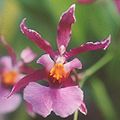
It is best to grow on one side of the pot and it will need to be repotted every 2 to 3 years. Grow them in moderate humidity in the shade in summer and more light in winter. Water sufficiently on winter to maintain the foliage and water freely in summer.
PRIMULA x POLYANTHA (Polyanthus)
These attractive plants often seen outdoors have large heads of flowers that are borne above a rosette of stout, green leaves. It comes in many colours and the flowers are often fragrant, where it can reach a height of 38cm.

It is a hardy plant and is suitable for the coldest part of the house in light shade. Do not grow in warm, stuffy rooms, as they will not do well. You will need to keep them indoors for the flowers and once it has finished, it needs to be placed outside in a shaded area. The plant will need to be fed and watered to keep the plant going.
It is best to move the plant once and then grow new specimens every year for indoor use.
It is best to grow them from seeds but the growth should be done outdoors in May, where the flowers should be produced in the following spring. After flowering place the plant in window boxes outdoor to give many years of colours. The plant should never be allowed to dry out at any time, particularly in summer.
ROSA (Rose)
These are attractive plants that have their place in the home. They have the familiar flower shape, colours and scents that are found in garden roses, but they have been bred to tolerate indoor conditions.
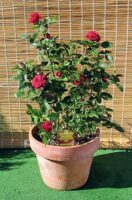
They have been bred to grow far smaller than other roses and generally bring cheer to most homes. The roses’ look smaller but they do not lose their charm in their miniaturization. Some will say that some look prettier than the large varieties. The roses will bloom from early summer until the end of autumn and they come in reds, pinks, whites and yellows.
All these roes need is plenty of light and so a sunny window sill is ideal, providing you give plenty of ventilation. In winter, they will need complete rest; keep them cool and cut back on watering. It is best to keep the shrub in average to room temperature, where they can grow up to 40cm in height. To keep the plant flowering, deadhead faded flowers regularly. This will encourage the formation of more buds and do not worry if it loses leaves in autumn, as this is perfectly normal.
STEPHANOTIS (Madagascar Jasmine)
The Madagascar jasmine is an elegant, evergreen climber that has waxy, white flowers that are set against dark green, glossy leaves. The flowers appear in spring to early autumn, where the pleasant scent makes it a wonderful houseplant.

It is a long term houseplant and it can be encouraged to flower for years and years. Grow it in bright, indirect light in warm summer temperatures, cooler in winter. This 6m climber needs to be watered freely in summer, sparingly in winter. The plants can become rampant and so will need careful training and pruning to keep it small and in great shape, for all to enjoy.
CONCLUSIONS
In this article, we have discussed the best-scented houseplant to have in your home. As you can see there are quite a few to give pleasure to your nostrils. Houseplants that not only look great, but they also smell great. They will provide years of enjoyment, provided you look after them right. They should appeal to all no matter your preference for flower colours, leaf shapes and form, and heights. There is a scented houseplant for you.
If you have any questions that you need to raise or comments that need to be made, please do so in the comment box below.
Get your nose twitching in appreciation!

I loved your article on the best indoor plants! Some really great suggestions but for me by far is the Lilys. Stargazer lilys are so gorgeous and make our home smell so good and very inviting. I will definitely give a couple of others that you’ve mentioned here ago. Thank you for sharing this flower wisdom and knowledge.
Hi Michael
I have gone for plants that are a lot of people’s favourite and lilies are one of them. It is a shame that ot will last one growing season indoors but the other plants include specimens not often seen in the home. Time to broaden people’s horizons.
Thanks
Antonio
Thank you for sharing your article about the House plants for welcome indoor scents. I have gone through it all and liked the detailed information which you have provided about each of the flowers individually. So that if a person would like to consider planting one of them, they have all the information right beside as to follow those instructions.
I liked very much the purple one because of its elegant and beautiful color and of course when you said about its pleasant scent. I haven’t smelled it yet but the way you explained, I can imagine it may have the best scent.
All the best!
Hi Meenaf
I find it frustrating when prople come up with a suggested plant that you have to go elsewhere to find how to plant them and look after them. People, in general do not know how to look after the plant well and to give them in a concise manner, will help them no end.
My person favourite is heliotropes, such a beautiful, scented plant.
Thanks
Antonio